This is an HTC Desire review – one of the fastest and the most powerful cell phones based on Android 2.1 OS. It has a 1GHz Snapdragon processor and a large AMOLED screen that consumes little energy and never gets crazy or hangs in cold weather. That’s true. But we have doubts about its visibility in sunlight that is proclaimed to be good by the manufacturer (we did not really see much difference from an LCD). The images on the screen of HTC Desire are so sharp and clear that they seem unreal. AMOLED screens have some disadvantages. The worst of them is their limited lifetime. They consist of OLEDs (organic light emitting diodes) that degrade rapidly.
Results
The design of the box is simple (pic. 1).
In the box (pic. 2):
- Battery charger
- USB cable (charger cable)
- Headphones
- Documentation
When we looked carefully at the HTC Desire we understood that its build quality was not top notch. The back cover was not closely attached to the chassis in some areas. There was a play of the up/down button. The power button is protruding. It is raised above the chassis. Sometimes we pressed the power button accidentally and each time it functioned as a lock key (the display went off and the keypad was blocked as it happens when we lock all the other cell phones).
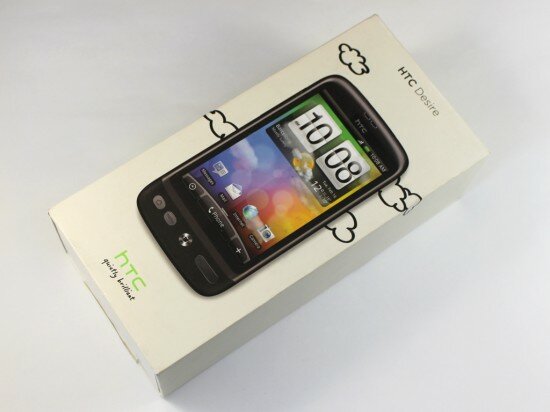
Pic.1. Box
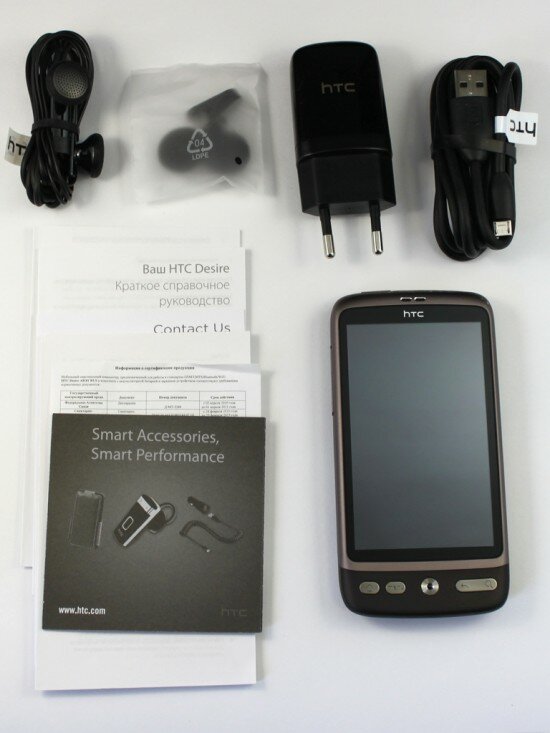
Pic.2. Accessories
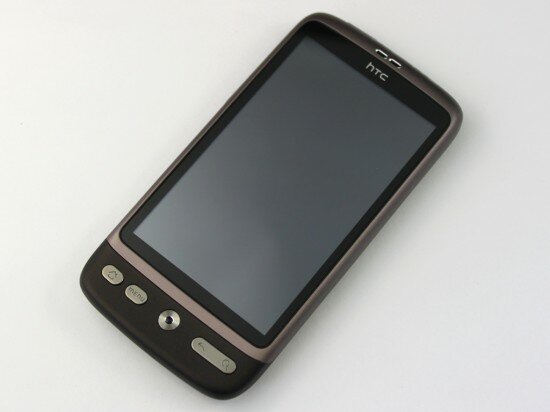
Pic.3. HTC Desire front side
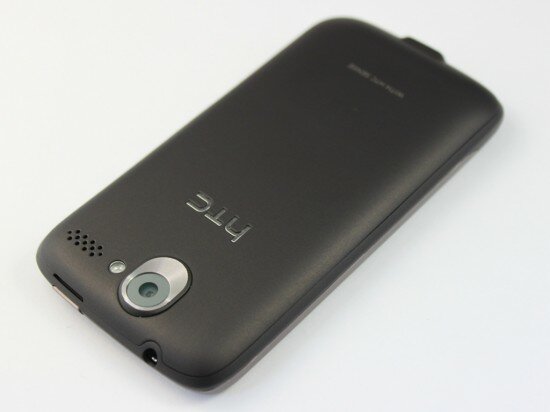
Pic.4. HTC Desire back side
1. HTC Desire stress test. Stage 1 — Ability to withstand light shocks
1.1 Drop-down
First of all we found out how the HTC Desire could deal with the fall from short distances. We sequentially dropped the phone onto each face and edge for 6 times from 1m (3 ft) on a carpet (video 1) and from 30 cm (11,8 inches) on a ceramic tile (video 2).
The handset easily passed the drop test. Once it fell onto the top edge the power button functioned as a lock key. The corners of the HTC Desire are rounded. It made the phone bounce off the floor greatly. But it was not damaged.
Video 1. Drop on the carpet from 1m (3 ft)
The grade is 30 from 30 possible
Video 2. Drop on the tile from 30cm (11,8 inches)
The grade is 30 from 30 possible
1.2 Squeeze test
When a cell phone is left on a chair or on a bench one may sit down on it by accident or even step on it if the handset is on the floor. We simulated such a situation by putting the HTC Desire on a table and applying a 3 kg (6,6 lbs) pressure from a wooden bar above (pic.5). The handset passed this test with no problems at all.
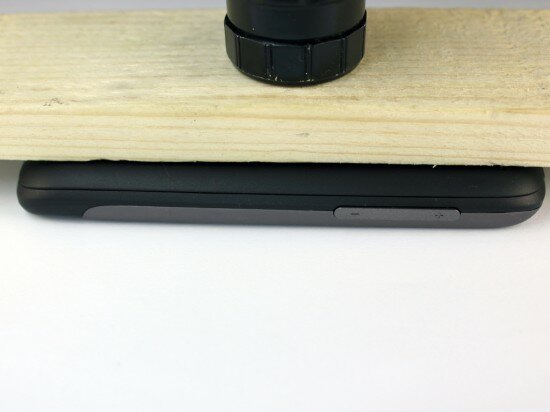
Pic.5. The phone under the wooden bar
The grade is 24 from 24 possible
1.3 Bend test
A bend test can be considered as a type of a squeeze test. But it is tougher and more disastrous for a gadget because the force of pressure is not spread equally around the handset as it happens in a squeeze test. On the contrary all the force is concentrated in a particular area of the phone. And it happens more often in real life, for example, a person may sit down on a chair with a mobile phone in the back trouser pocket.
But we put the HTC Desire onto the two planks so that each edge of the device lay on a plank. Then we hitched a string with 1 kg (2,2 lbs) load over the phone (pic.6). The handset passed the test well.
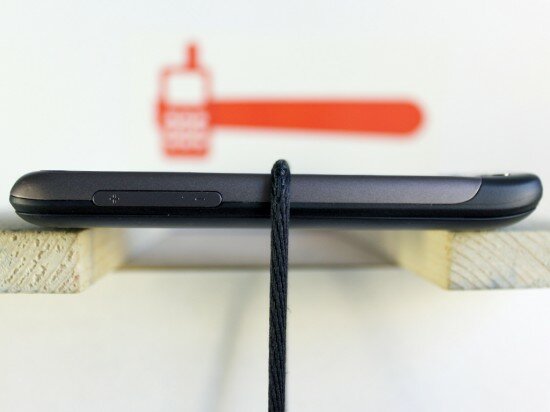
Pic.6. Bend test
The grade is 24 from 24 possible
1.4 Durability
In order to see how the phone will look after a long period of negligent treatment we made the following test: we put the HTC Desire in a drum with keys, pennies and somre other plastic things to simulate what might be happening in a man’s trouser pockets while carrying a handset there. The drum was rotating for 5 min. (video 3).
The device was really damaged. There were deep scratches on the aluminium band (pic.7). Some scuffs appeared on the “soft touch” texture of the back cover (pic.8). The screen glass was damaged but little (pic.9).
Video 3. Drum rotation
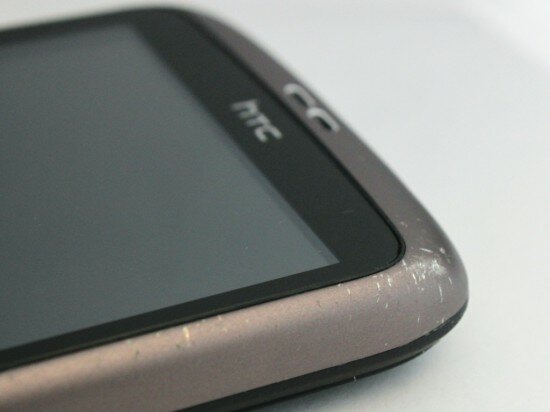
Pic. 7. Scratches on the aluminium band

Pic. 8. Deep scratches on the “soft touch” texture

Pic. 9. Small scuffs on the screen glass
The grade is 10 from 15 possible
1.5 Scratch test
Another way to test durability of a handset is to scratch it with a nail. We made a scratch on the back cover and on the screen. The force of scratching was 100 g (0,22 lbs). Check out video 4.
The back cover was not damaged due to its texture. The screen was also safe. So the phone passed this test perfectly.
Video 4. Scratch test
The screen gets 15 from 15 possible
The back cover gets 15 from 15 possible
1.6 Hot temperature
It is widely known that an AMOLED screen works with no problems in cold weather. But how it can deal with heat? We found the answer after the following test. At the first stage of the experiment we put the HTC Desire in a small can together with a 40 Wt electric bulb so that they were very close together. Then we switched the bulb and it was heating the phone for 3 min. (video 5).
After the test the phone looked as if nothing had happened. It performed perfectly and its color rendering was good.
Video 5. Hot temperature test
The grade is 12 from 12 possible
1.7 Dust test
Dust is everywhere and a mobile phone can’t avoid it. Even if you keep your phone in a pocket or in a case all the time dust will penetrate inside anyway. However the majority of handsets are able to protect themselves from dust. How dust resistant the HTC Desire is? This test will give us the answer. Actually we had an enclosed tray with dust thrown in with the phone. Then we were vibrating it violently for 2 min.
Have a look at the phone immediately after the test (pic.10). Many grains of dust penetrated in the seams between the housing faceplate and the buttons. It took a lot of time and efforts to clean it. Probably through these seams some dust penetrated even under the screen glass (pic.11). In order to get rid of this dust and sand we had to disassemble the HTC Desire. The back cover also failed to protect the gadget from dust. There were plenty of sand under it (pic.12). Some metal grains of dust stuck to the loudspeaker.
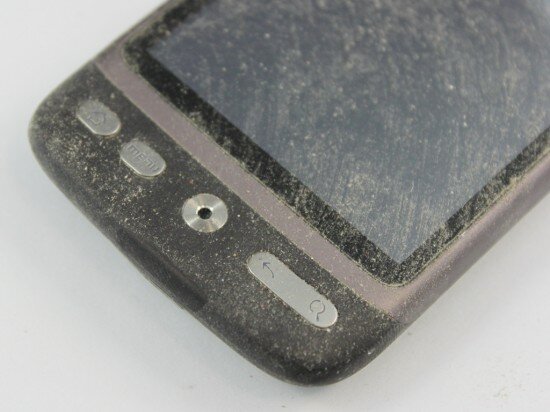
Pic. 10. The bottom edge of the phone after the test
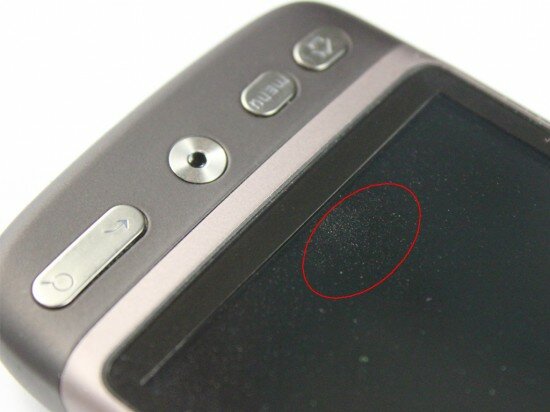
Pic. 11. Dust under the screen glass
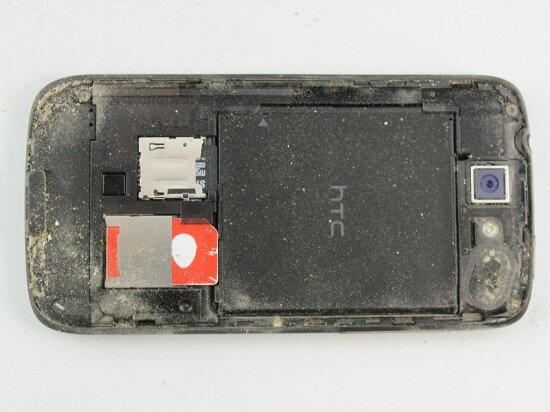
Pic. 12. Small grains of dust under the back cover
The grade is 8 from 12 possible
1.8 Connectivity
Any communicator has a great deal of functions but signal reception quality is still the essential criterion.
In order to know how good the HTC Desire is at receiving calls we put it in a box covered in foil. The foil served as a shield (if it is possible to say so) that prevented the phone to receive electromagnetic waves sent from a tower. Then we made a 45 mm x 40 mm (1,77 inches x 1,57 inches) hole in the box through which the handset could receive the signal. But anyway the signal was reduced (video 6).
The phone received all the calls successfully. The signal strength was displayed on the screen by 3-4 bars. That’s a good result.
Video 6. Connectivity test
The grade is 15 from 15 possible
After the 1st stage of the stress test the HTC Desire got 183 (from possible 192)
2. HTC Desire stress test. Stage 2 — Tough conditions
2.1 Drop test
At the second stage of the test we decided that the height of the fall on the carpet should be 1,5 m (4,9 ft) and the height of the fall on the tile should be 50 cm (1,64 ft).
However when we dropped the HTC Desire for the second time onto its left edge (on the carpet) the screen glass of the phone cracked (video 7). Fortunately the sensor was not damaged and the display performed well.
We did not expect that after the second fall the screen glass would be broken. So we tried to find the reason why it was damaged and why the cracks appeared in the form of a line that went aslant the screen (pic. 13, 14). Imagine that the screen is a rectangle. The cracks constituted a line joining the two nonconsecutive vertices (like a diagonal) of this rectangle. We found out that it happened because the opposite corners of the handset were heavily pressed in opposite directions that consequently led to the crack of the screen glass. The majority of cracks were near the volume button (pic. 14). In this area of the phone the aluminium band that runs round the screen was thinner than anywhere else. That part of the device turned to be the weakest and therefore it suffered most of all.
We decided not to continue the drop test and to omit some other tests because it could change the result that we had already had.
Video 7. Drop on the carpet from 1,5 m (4,9 ft)

Pic. 13 The broken screen glass
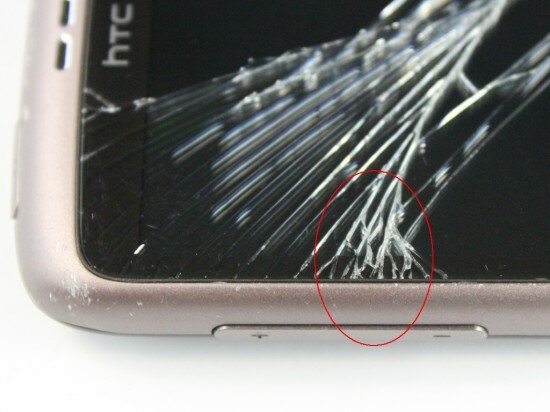
Pic. 14. The area near the volume button that was damaged most of all
The grade for the drop on the carpet is 20 from possible 30
The grade for the drop on the tiles is 0 from possible 30
2.2 Squeeze test
In this test there is no risk for the screen to be damaged because the pressure is equally distributed around the handset. That was the reason why we decided to make it. This time the force of the applied pressure was 10 kg (22 lbs). In the result the back cover deflected a little but in general the HTC Desire passed the test well.
The grade is 24 from 24 possible
2.3 Bend test
The test was not carried out.
The grade is 0 from possible 24
2.4 Durability
The test was not carried out.
The grade is 0 from possible 24
2.5 Scratch test
This time we increased the force of scratching to 300 g (0,66 lbs). The scratch on the back cover was not deep at all and we could hardly see it. We tried to scratch the area of the screen that was not cracked but we failed. The screen glass turned to be ruggedized though it was badly damaged in the result of the drop test.
Video 8. Scratching the handset
The screen gets 15 points from 15 possible
The back cover gets 15 points from 15 possible
2.6 Freeze test
It was time to carry out the freeze test. We found out for how long the HTC Desire could work in extremely cold weather and how the AMOLED screen was good at performing in such conditions. Actually we put the phone in a freezer for 2 hours. It was in a speaking mode throughout all the experiment.
Unfortunately the HTC Desire failed this test. The battery became absolutely empty in an hour (video 9). We plugged in the battery charger to supply the phone with power and started examining it. The display performed well. The touch screen was still very sensitive in spite of the fact that it was frozen. But the keys were really bad. We did not hear the clicking sound of the buttons that was always produced when we pressed them. But then we warmed the phone and the buttons started to function well again.
Video 9. Freeze test
The grade is 6 from 18 possible
2.7 Hot temperature
We increased the time of the test to 5 min. The result was the same as in the first stage of this experiment. The phone was safe and the display performed well.
The grade is 8 from 12 possible
2.8 Immersion in water
The test was not carried out.
The grade is 0 from possible 24
2.9 Dust test
The test was not carried out.
The grade is 0 from possible 24
2.10 Connectivity
We covered a new box in foil and made a 20 mm x 20 mm (0,787 inches x 0,787 inches) hole in it. The smaller the hole the worse the signal reception is. Then we put the handset there and made a call on it (video 10).
It was problematic for the HTC Desire to receive all the calls in such conditions. Sometimes we heard: “The subscriber is temporarily blocked or out of the coverage”. However the majority of calls were successfully received by the phone. So the result was worse than in the previous connectivity test. The signal strength was displayed on the screen by 2-3 bars.
Video 10. Connectivity test
The grade is 10 from possible 15
After the 2nd stage of the stress test the HTC Desire got 102 (from possible 240)
3. HTC Desire stress test. Stage 3 — The toughest conditions
3.1 Drop test
The test was not carried out.
The grade for the drop on the carpet is 0 from possible 30
The grade for the drop on the tile is 0 from possible 30
3.2 Squeeze test
At the third stage of the test we increased the force of the pressure to 20 kg (44 lbs). The lower part of the handset is protruding. This shape can be the weak point in the squeeze test. However when we applied the pressure from a wooden bar above nothing bad happened to the phone. The HTC Desire passed the test successfully.
The grade is 24 from 24 possible
3.3 Bend test
The test was not carried out.
The grade is 0 from possible 24
3.4 Durability
The test was not carried out.
The grade is 0 from possible 15
3.5 Scratch test
The maximum force of scratching was 600 g (1,32 lbs) Check out video 11, 12. We made a very deep scratch on the back cover. The “soft touch” texture was scratched off (pic. 15). But we failed to make a scratch on the screen. The screen glass was really strong though in the drop test it was broken.
Video 11. Scratching the back cover
Video 12. Screen scratching
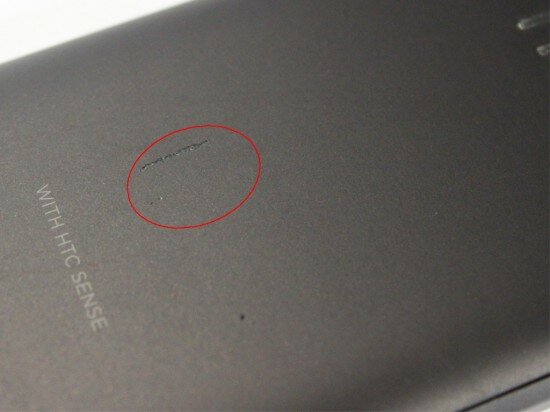
Pic. 15 Scratches on the back cover
15 points (from 15 possible) for the screen 10 points (from 15 possible) for the back cover
3.6 Hot temperature
In the previous test the bulb was heating the HTC Desire for 5 min. But we increased the time of this experiment to 10 min.
In the result of the heating the screen went dark and the images became unclear (video 13). When the phone cooled down the display was as good as before the test. The handset survived. It did not melt at all as the other gadgets did when we put them in this conditions. However we must admit that the screen glass was too hot.
Video 13. Hot temperature test
The grade is 12 from 12 possible
3.7 Immersion in water
The test was not carried out.
The grade is 0 from possible 30
3.8 Immersion in beer
The test was not carried out.
The grade is 0 from possible 9
3.9 Dust test
The test was not carried out.
The grade is 0 from possible 12
3.10 The keyboard
We can’t say that the keyboard of the HTC Desire is of a high quality. There is a play of the up/down button on the left-hand side of the phone. The power button is raised above the chassis. So you may press it by accident. Dust and liquid can easily penetrate inside the phone through the seams between the front buttons and the housing faceplate.
The buttons work badly in frosty weather. It may take you two times more efforts to press them. This disadvantage really irritated us. By the way you may damage a button if you press it heavily.
The grade is 10 from 15 possible
3.11 Connectivity
We covered a new box in foil again and made a 15 mm x 15 mm (0,59 inches x 0,59 inches) hole in it. Then we put the handset there and made a call on it. The phone showed a very bad result (video 14). The HTC Desire received only 4 calls out of 10. For 6 times we could not connect to the subscriber because it was either blocked or out of the coverage. The signal strength was displayed on the screen by 2 bars (50 %).
Video 14. Connectivity test
The grade is 5 from possible 15
3.12 Short circuit and overcharge
At first we tested the battery. We connected the contact points “+” and “-“ with the help of forceps. The short circuit lasted for 1 sec. (video 15). The battery board prevented the cell from discharging. That was a good result.
Video 15. Short circuit of the battery
The grade is 15 from possible 15
Then we did the same with the charger. We connected the contact points of the charger with the help of the forceps (video 16). The experiment lasted for 1 sec. The charger worked as good as before the test.
Video 16. Short circuit of the charger
The grade is 15 from possible 15
Then it was the HTC Desire turn. We found out the reaction of the phone to a charging power change. Actually we plugged the charger cable in a Power Supply Unit (PSU). Then we were gradually decreasing the power of charging (video 17).
We found out that the handset performed badly when the charging power was weak. For example, we saw on the screen that the phone was still charging when the power was 3,7 V. But the red indicator on the left hand side of the PSU showed that there was no power supply. So the charging was impossible.
When we increased the power supply the HTC Desire stopped charging in order to protect itself from a possible damage. But it happened when the power was 7 V. Fortunately the device consumed as much energy as it needed and no more.
Video 17. Increase/decrease of charging power
The grade is 10 from possible 15
At last we found out how the HTC Desire could deal with overvoltage. We plugged in the electric power generator instead of the battery.
Nothing of the kind! We could not even switch on the phone. It refused to perform with “false” battery. We can’t say whether it is good or bad. For a person who owns HTC Desire this is an advantage because they needn’t worry about the safety of the phone if the battery is broken. They just need to replace the battery. But it makes it more difficult to repair the handset because it is necessarily to plug in the electric power generator in order to reveal the broken component.
Video 18. Overvoltage
The grade is 15 from possible 15
3.13 Disassembling
We disassembled the HTC Desire in order to know as much as possible about its build quality (pic. 16). But we saw nothing knew. The assembly was typical for the phones produced by HTC Corporation. The manufacturers used a lot of adhesive tape, double-sided sticky tape, conductive ribbon and adhesive foil to produce the phone. All the possible components of the handset can be easily replaced. We were pleased to see the sealant that was used together with the board to board connectors (b2b). We have never experienced to see it in the other handsets.
The phone does not have a metal frame that could make it rigid. For such a large cell phone as HTC Desire the frame is one of the most important things. As far as we could judge the aluminium band that runs round the screen and the thin metal plate did not protect the phone in the drop test. It led to the crack of the screen glass.
The circuit board was quite simple. A lot of components were placed near the processor. The rest of the board was empty (pic. 17). You can see the circuit board and the interior design of the keyboard at picture 18.
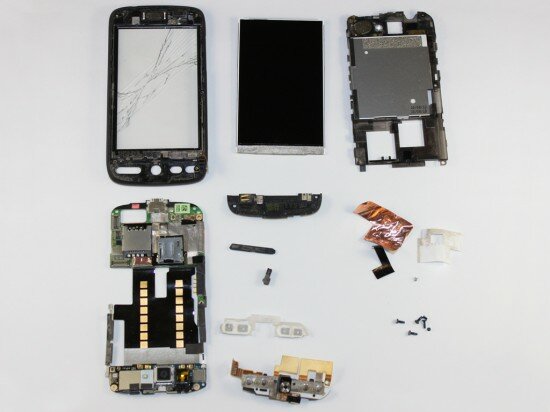
Pic. 16. The phone disassembled
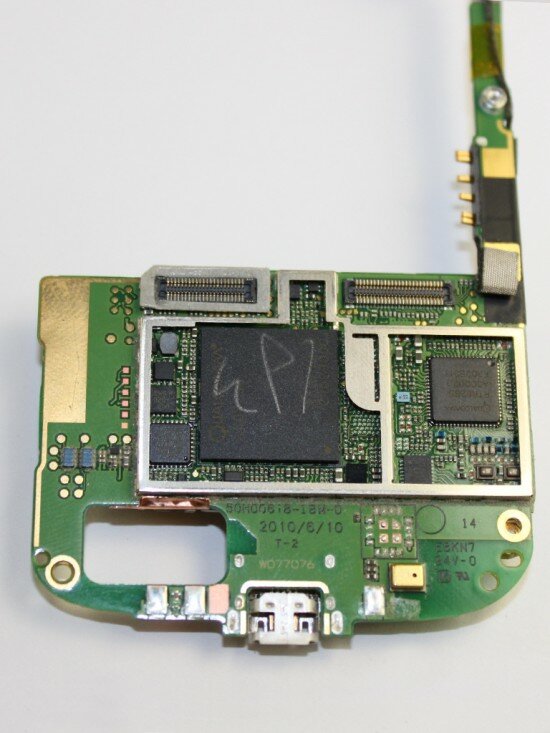
Pic. 17. HTC Desire circuit board

Pic. 18. The upper part of the circuit board and the keyboard
The grade is 20 from possible 20
For the 3rd stage of the stress test the HTC Desire gets 161 points from possible 351.
The HTC Desire showed a bad result in the test. The worst thing that happened was the crack of the screen glass in the drop test. And just keep in mind that the phone did not fell on the tile. The screen cracked after the phone fell on the carpet from the average height. This is the first case in our practice when a screen glass is broken.
There are the other disadvantages. The aluminium band is not durable at all. It was very easy to damage it. The handset is not dust resistant. Some dust penetrated even under the screen glass. It rarely happened to the other phones that we had tested. The buttons functioned badly in frosty weather.
The AMOLED screen was not as brilliant as we expected. The build quality is not very high. The materials of which the device is made and the “soft touch” texture are not durable. To cut a long story short the HTC Desire is not a ruggedized cell phone.
Video 19. The HTC Desire after all the tests
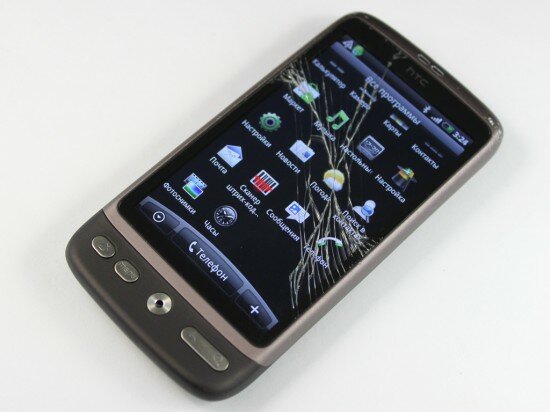
Pic. 19. The front of the phone after the tests
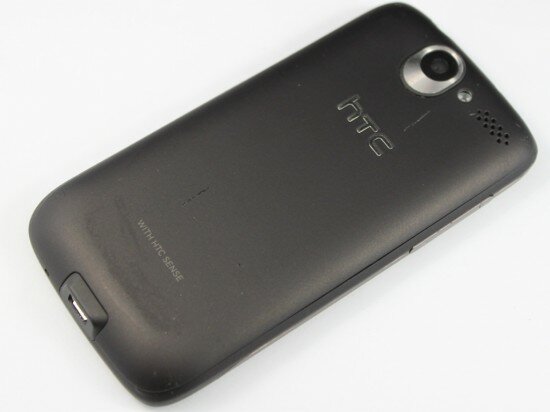
Pic. 20. The back of the phone after the tests
All in all the HTC Desire gets 466 points from possible 783.
According to 100-rating scale the phone gets only 59 points.

 Russian version
Russian version
Comments (7)
This test is unfair in that it does not mark the phone on many aspect but includes the 0 score from those tests.
You must have tested a bad device.
It’s known that dust only gets under the screen when you have a Desire with a bad seal – and those models are replaced on warranty.
Also I’m wondering about the fall test. I dropped mine several times on wooden floor from about 1,5 meters height and never saw any damage.
If a test wasn’t carried out, then it should be 0 of 0 points, not 0 of 30.
That makes the test nonsence
I tallied it up and 246 points were subtracted from the device for tests not carried out. Is someone paying you to artificially lower the scores or are you guys just terrible journalists?
I’m surprised the HTC lasted as long as this. Mine lasted just 2 months!!! I kept it in a protective case and never dropped it, but it didn’t survive the rigours of a holiday featuring…..a bike ride and walking around the streets. I didn’t even keep it in my trouser pockets in case it bent. My old iphone lasted 2 years without a problem. I really regret buying an HTC phone – just not durable and they haven’t thought about longevity.
If you subtract all the tests that weren’t performed the total possible score is 507, so 466 out of 507, or 91.9 out of 100. Not too bad all things considered. The only fair way to get the real score, I suppose, would be to run all the remaining tests with a new phone, since the likelihood of the screen breaking under the conditions of test 2.1 isn’t that high in my experience.
Tis is obviously a website tat is pro-iphone… wasted my time reading tis and how is it possible tat a mass-produced (a.k.a cheap before being marked up ten-fold) product could be tis durable… plus some of the tests were nvr conducted on the desire and yet the maximum score was not adjusted accordingly…
Trackbacks/Pingbacks (2)
[...] by a 1200 mAh LI-Ion battery, by the way. The 135 grams of weight make the Nokia N8 as hefty as the HTC Desire that we tested not very long ago. Results Pic. 1. Package box Pic. 2. Accessories Pic. 3. Nokia [...]
[...] so long ago we tested the other popular Android smartphone: the HTC Desire. It showed absolutely the same results in this [...]